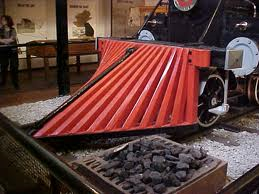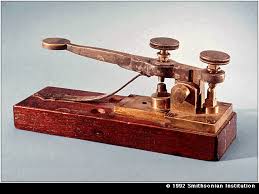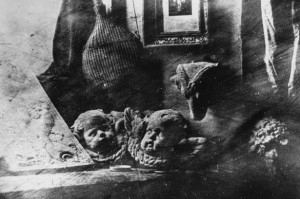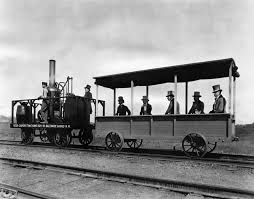2014 is the New 1844
~ In the decade of the 1840’s a series of catalytic technological leaps conspired (in a good way) to turbocharge the era and toggle society from primitivism to modernity. ~
The pervasive wizardry of the Digital Age has palsied our ability to appreciate its origins. It seems the ubiquity of ever-advancing gadgetry has quietly rendered us both a slave to its expediency and a marveller at its everyday sorcery. Whether it’s asking Siri to; “Find me the nearest Weinershnitzel” or waving our sudsy hands beneath a motion-detecting faucet, we’re unthinkingly demanding of the technological feats which, until recently, were nothing more than crack pot ideas found in the back of decade’s old Popular Mechanics magazines.
A proper accounting of how we got here demands a deliberative look at where we came from. Being fortunate enough to have missed the Dark Ages (unless you count the Disco Era), I have a mighty appreciation for the technological marvels which have allowed us to avoid the drudgery of the past. For example, there was a time when Wheel of Fortune hostess Vanna White had to actually turn the letters by hand. Such drudgery! Now she just touches a screen and the letters magically appear. This kind of enabling touch-screen technology will add years to Vanna’s letter-revealing hostess duties.
Past is Prologue

The hallmark of any modern society is the effective use of waxed lips. Here little Timmy looks perfectly at ease with his starter set.
The Shakespeare maxim “What is past is prologue,” is inscribed on the National Archives Building in Washington DC. This quote memorializes the notion that every society throughout history believed theirs was a modern society possessing remarkable attributes of advanced achievement; just like we believe ours is today. And we are a modern society. Right now at least. But in the future we may be ridiculed for our antiquated ways e.g., the Electoral College, non-alcoholic beer and wax lips. Similarly one can imagine the pantheistic Egyptians scoffing at the cluelessness of the primitive hunter-gatherers who preceded them – “All they did was pick up stuff and eat it. I’ve got an Ibis that does that.” Perhaps in their time the empire-building Romans belittled the vulgar savagery of Attila the Hun. Although I don’t see how, since Attila the Hun came well after the fall of Rome. And why do we have to call him Attila the Hun? To my knowledge he’s the only person in history ever named Attila. Certainly the only well-known Attila. I’d never confuse him with say Attila the Cobbler or Attila Who Dances with Wolves.
Perhaps one day the inheritors of our society will convulse in laughter when they consider our society’s antiquated ways such as the Electoral College, non-alcoholic beer and wax lips. And while it’s cool to repeat yourself now, it may be quite the “epic failure” in the future. Yes, we may grow sentimental projecting ourselves back into the “gallant glories” of Ancient Rome, but one trip to a Roman outhouse where your left hand was known as toilet paper, will instantly send one rocketing back to the future where flush toilets equipped with rolls and rolls of clean white toilet paper that can be unfurled to soothe both our bottoms and our minds.
Unchanged for 15 Billion Years
Prior to the steam engine’s use in watercraft around 1800, everything in life moved at the speed of hooves, wind, or water. We were all on nature’s timetable and subject to its pace. In antiquity they didn’t have moving sidewalks or stationary bikes. They didn’t even have air bags back then, unless you count King Henry 8th. Oh the man was long-winded, not to mention short-tempered. To be sure there were a few abortive attempts to overcome nature’s forces like Attila’s Catapult Taxi (really more of a way to thin uncooperative Huns from the herd). And in case you were confused as to which Attila I was referring to, it was Attila the Hun. Icarus’s ill-fated wax wings weren’t exactly hi-tech either.
Occasionally technological advancement is carried too far. For example, in the preposterous movie “Her”, a man falls in love with a sultry cyber-voice from his lap top. And although it was cinematically well-executed, the smitten protagonist repeatedly shocks himself while trying to penetrate her motherboard. But this essay is not a “Man bites computer” story. Instead it’s an examination of what I believe to be the previously unremarked pivotal period when Western society toggled from primitivism to modernity. A decade where we collectively leapt from the speed of hooves to the speed of light. I call it the original Quantum Leap. We’ll get to that in due course.
A Paper-Thin Primer on the Impact of Technological Evolution (with jokes)
Human passions may not change, but the tropism of technological growth is ceaseless. We may not have done anything to improve our core strength in 25 years, but in that time we’ve managed to completely reinvent and upgrade our music formats. What started with Edison wax cylinders led to vinyl records to reel-to-reel to 8-Track to cassette tapes to CDs to mp3 and finally back to retro-vinyl records. Everything old is new again. Just ask Cher or Betty White. This technological jump is welcomed by consumers of SONY Walkman’s who “back in the day” would go jogging with a servant running alongside holding an RCA Victrola to their master’s ear.
How did we survive with just 3 TV networks who stingily doled out entertainment like it was gruel being ladled out to Oliver Twist. More please? And many of these shows were grueling – Lamp Unto My Feet, The Lawrence Welk Show and The United States Steel Hour. The United States Steel Hour was so boring it seemed to last 2 hours. At least we could tune in to the manly camaraderie of Hogan’s Heroes or the sweet release of I Dream of Jeanie. How my generation ever negotiated the slippery slope of adolescent irrelevancy and emerged as full-fledged contributing members of society I’ll never know. I’ll never know because I’m not a full-fledged contributing member of society. I’m more a partially-fledged associate member whose quaint idea of hi-tech gadgetry are those metal grates at the front of railroad engines called Cow Catchers. These metal plows prevent an errant cow from wedging itself underneath the wheels of a train and derailing it. Cow Catchers seem like an elegant idea to me; whereby an unsuspecting cow just idly standing on the tracks is delicately scooped up by the ever-caring mechanism and gently deposited trackside where her udders are once again ready for man’s exploitation. This boggles my aging mind; which, as you may have noticed, is easily boggled these days.
I can remember the bad old days when telephones and newborn babies still had cords attached to them. Nowadays some babies are born without umbilical cords courtesy of Google’s new birthing app called GoogleGooGoo. GoogleGooGoo has spawned the first generation of wireless newborns. That’s right. No cords. These Wi-Fi babies are born with an onboard GPS and even a Moral Compass that detects psychological bottlenecks and may advise: “When able please reconcile with your birth mother.” If it determines your life goals are unachievable the GPS may thoughtfully counsel, “Recalculating. And maybe you should too.” In controversial Build 1.1 the GPS was upgraded with software that displayed chapels performing same sex marriages as well as NRA offices. Cuckoo stuff. And once again my mind is boggled.
Origins of Old School
The term “Old School” is a much abused term referring to the supposed charms of doing things in a satisfyingly primitive manner. And through the edifying inconvenience of that rough-hewn event somehow the experience miraculously becomes more genuine and nourishing. This is complete bullsh*t. But it’s a sentimental belief we humans cling to so we can play the “You don’t know how good you’ve got it” card. I don’t want to go back to a time when barbers were also dentists and surgeons. Barbers should only be allowed to cut things without nerve endings. I don’t want to go back to a time when the sun went around the Earth and when domestic abuse was known as marriage. Let us not forget there was a time when an Amber Alert was a warning parents issued to prehistoric children if they got too close to the La Brea Tar Pits.
Was there a joy in driving Old School cars without seat belts, air bags or ABS brakes? Or was their perverted pleasure to be found in knowing you were one abrupt stop away from making an impression on the metal dash or impaling someone on the hood ornament? Did you enjoy flirting with ignorance and danger so you could subsequently refer to the charms of doing things Old School? Did people enjoy living Old School in a house heated by fireplaces that could only warm one side of your body and when you awoke in the morning the glass of water you placed on your nightstand was now a glass of ice? Oh sure we love Old School in theory, don’t we? Take away our ATM card and we might Instagram a selfie of us crying. So while Old School is a place we might like to visit occasionally (think making popcorn in a pot instead of microwaving it), Old School is certainly not an institution we’d want to graduate from. It may be fun to invoke the term Old School to display our bona fides, but no one except maybe Thoreau or that “Into the Wild” guy wants to go back there.
So be thankful every second of every day you can soothe your loneliness by playing solitaire on your computer, because back in the day playing solitaire meant sitting alone at the end of your bed waiting for the hunger pangs to go away or for the sun to come up. But that was only during the 4 minutes of leisure time people were allotted each day. The rest of the time was reserved for darning your socks or darning your stupid life. All this deprivation sounds semi-cool on paper, but try actually experiencing it. You wouldn’t last beyond Day 2 without imploring, “Please. Someone’s made a terrible mistake. I’ll kill myself if I have to churn any more butter or bring in any more sheaves; and I don’t even know what a sheave is. Please help me get back to where I can play solitaire on demand.” In no time you’d be like Dorothy tapping her shoes together and repeating, “There’s no place like home. There’s no place like home.” Now whose mind is boggled?
At least sex has remained Old School. It has no choice. You’re either in or you’re out – so to speak. Sex isn’t discriminatory. The same absurd choreography of human love that birthed William Shakespeare and Isaac Newton, also begat Colonel Klink and Queen Latifah. Sex hasn’t changed in eons and remains a beautiful thing to this day; despite what’s on the Internet (from what I’ve heard). It lifts us up where we belong, depending, of course, on the position you use. All this is a roundabout way of saying Tom Petty was right – you don’t have to live like a refugee.
There was a time when Old School was the only school available. It was then known simply as School. Old School was a time when the first Pyramid was just a few blocks of low grade limestone randomly stacked in the Pharaoh’s sandbox like so many Jenga pieces. It was a time when life moved at the speed of hooves; and electricity, anesthesia and iPhones were those things with feathers. There was no “back in the day.” It was the day. Until of course night time came and then everything turned black until the discovery of fire. Then people no longer had to curse the dark. They could light a candle and then fall asleep with it lit thereby burning down their homes unless they had a Old School Dalmatian to alert them.
The First Quantum Leap is the One that Matters Most
So far this essay has presented an historical survey of technological advancement that’s a mile wide and an inch deep. By employing silly comparisons, curious factoids and consciousness-pricking sarcasms it has described a few of the sublime incongruities of human endeavor, proving that humor is an arsenal of enlightenment and that when no one is policing me sometimes my sentences will go on forever. Well we’ve had our fun and now I propose something different. I will now reverse engineer the whole process revealing exactly where the headwaters of all this invention sprung. I’m so anxious and giddy to share this with you, I hope it’s not all over in 30 seconds, as sometimes happens with events like this. I’ve softened the ground with a steady rain of background, context and data. Now you’re ready to absorb a sprinkling of truth or in this case my thesis:
~ In the decade of the 1840’s a series of catalytic technological leaps conspired (in a good way) to turbocharge the era and toggle society from primitivism to modernity. ~
Around and about 1840 I detected a technological tide in the affairs of men, which, taken at the flood, led on to a dazzling array of inventions (to butcher Shakespeare). And the synergy of these inventions has precipitated a deluge of other unanticipated inventions flooding us with numerous conveniences. This fire hose of everyday wizardry has palsied our ability to understand or appreciate their origins – especially to appreciate the grind of existence prior to their invention. The 4 inventions/discoveries I’ll enumerate enabled and accelerated the advancement of mankind and created a quantum leap in the human experience. They all appeared in the 1840’s and were the sine qua non of all technological advancement we enjoy today.
1. The Telegraph
The telegraph caused an historic paradigm shift in how mankind related to the speed and accuracy of news. Prior to telegraphy, news was biased, spotty and generally unreliable – kind of like it is today. In 1844 Samuel Morse dash-dotted the first message on his newly invented telegraph machine. The prescient statement he sent was, “What hath God wrought?” It was the first text ever, and even though he was referring to an awful lunch of pigeon stew he’d just eaten, the larger point is that these electronic pulses traveled over strung wires from Baltimore to Washington DC at the speed of light. No longer was man confined to the speed of hooves. Man had for the first time harnessed electromagnetism. This was no mechanical printing press or seed-removing cotton gin. This was a quantum leap into God’s pantry to borrow a cup of magic. From this point on we could no longer rest our heads on the soft pillow of ignorance for we’d now witnessed the supernatural movement of invisibly powerful forces. Think about it. Without this singular invention there would be no online gambling, in fact their would be no online. Morse and his invention opened the magnificence of electromagnetism to the world and it would never be the same again.
The telegraph was not a game changer. It was a new ballgame. For 5 billion years life forms communicated by yelling or pointing or releasing pheromones indicating “OK, I’m wet and I’m ready.” The point is you had to be nearby to receive the message. But with the advent of telegraphy one could be many miles away (or kilometers away, if you were in Europe) and know immediately just what the hell someone was yelling about. Telegraphy confirmed what a skeptical Einstein later termed, “Spooky action at a distance.”
A Quick Aside. Like many great men of his day Morse was a polymath. That is he was conversant and capable in many fields of endeavor. In fact he was a skilled painter (see picture on left) as well as an early daguerreotypist. This 6′ X 9′ canvass was an epic painting on a vast scale. While living in Paris, Morse worked on it almost every day at the Louvre. Working at times on scaffolding it took two years (1830-32) to complete and contained 38 miniature grand master works which were then displayed at the museum. Each of the 38 paintings was fashioned in the style of its original artist i.e, Da Vinci, Titian, Raphael etc. In the left corner is Morse’s friend and author James Fennimore Cooper (Last of the Mohicans) with his family. Incidentally, another of Morse’s paintings hangs in the White House.
2. Photography
The advent of photography caused another historic paradigm shift in how mankind perceived people and places. Prior to photography, descriptions or paintings of things were often prone to exaggeration or imprecision. In 1839 Frenchman Louis Daguerre perfected a method of fixing a precise physical representation on a thin piece of silver-coated copper. The French Government agreed to pay Monsieur Daguerre an annual pension of ₣6000 to reveal the process to the world (which at that time was essentially Europe and America). People would never be fooled by hyperbolic representations again. One could see clearly the unadorned proportion of anything captured by the camera’s lens. Irrefutable, unassailable evidence. The method was transcribed and sent to New York City via packet ship in late 1839 where Samuel Morse was one of the first to utilize it. When assessing the enormity of his invention Daguerre exclaimed, “Quelle oeuvre Dieu a faite,” which oddly enough means What hath god wrought.
3. Railroads
Mechanized railroads caused an historic paradigm shift in how mankind related to distance. The Iron Horse, whose track mileages increased dramatically in the 1840’s, was supremely transformative in binding the nation while facilitating commerce and travel. In Ulysses S. Grant’s words, “It positively annihilates time and space.” To evolve from slowly walking or riding a horse to smooth, fast, restful railcars is a quantum leap. Grant was right, for his time. Imagine if he experienced jet travel or bungee jumping.
The significance of train travel cannot be overstated. Broadly speaking, railroads enabled business to reduce the cost of shipping by 80-90% when compared with horse and wagons methods, This kind of productivity gain is unprecedented. Railroads also transformed travel from a grueling, protracted and bone-jarring event to one of rapid, smooth comfort. In the 1840s consortiums scrambled to buy land, build track and improve locomotives.
4. Anesthesia
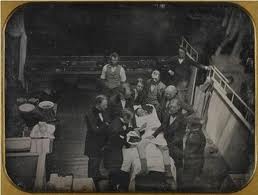
First surgery employing anesthesia. Here doctors check to see if patient is knocked out by tickling him.
The invention of anesthesia caused an historic paradigm shift in how mankind related to screaming in pain when cut open by a surgeon’s scalpel. Now they didn’t have to. The application of ether was the magic bullet in making a patient insensible. Putting surgery patients “under” during an operation was a powerful tool in the advancement of medicine. Prior to anesthesia, patients (or should we say victims) had to literally bite the bullet or get really drunk (seriously) in order to even begin to tolerate the unalloyed pain of being voluntarily lacerated by an unsterilized scalpel. Operations back in the day were nothing more than consensual horror movies. Try operating on someone squirming all over the table. It’s hard enough to make love to someone that way. Imagine trying to do all that and remove their appendix. All hail the great number anesthesia. Not #. Number, with a silent “b.” Anesthesia can put you out of your misery temporarily unless it’s administered by Dr. Conrad Murray. Then it’s permanent.
As Brevity is the Soul of Cogency…
…I’ll conclude my thesis with a few final notes. What do most people associate with the 1840’s? Nothing probably. But to me the 1840’s are a sublime portal to a whole other world. A transformative time when the world went from a dull gray predictability to the bright pink modernity. From flat to curved. And finally from blissfully plodding to newly self-aware. And how did it achieve all these descriptors? The 4 aforementioned inventions had a lot to do with it. But so did the agency of our 11th President James Knox Polk (1845-1849). Under his energetic stewardship this stalwart Unionist realized his vision of transforming our eastern seaboard republic into a unified and continental power stretching from sea to shining sea. This process is broadly referred to as Manifest Destiny. President Polk propelled Manifest Destiny by instigating and winning a war with Mexico thereby acquiring California and most of the Southwest. Additionally, while fighting Mexico on the South, he deftly avoided war with still powerful Great Britain on the North by peaceably settling the Oregon border question with Great Britain (up until 1848 we jointly owned the area) along the 49th parallel despite his bellicose 54’40’ or Fight campaign slogan. It should also be noted that the state of Texas entered the Union on his watch (How it fit on his watch I’ll never know.). President Polk acquired vast swaths of land for the federal union and gave shape to the United States we recognize today. And to gild this newly formed lily, the fortuitous discovery of gold in California in 1848 precipitated a flood of 49ers who flocked to the unpopulated territories via the Oregon Trail. Not only did we acquire all this new land but it was also being filled in by stout pioneers, many of whom we’re now able to transmit instantaneous electronic messages at modern railroad stations while looking at pictures of loved ones who’d had surgery while being anesthetized.
What killed drudgery? It was invention that killed the beast of burden. At least in the 1st World. In the 1st world drudgery was killed by invention. Well, with invention and cheap labor from the 3rd World. Did we toggle from ancient to modern overnight? No. But considering the span of human existence the switch was thrown during the decade of the 1840s and has been on ever since. The 1840s are the mother lode of catalytic events. Factors conspired (in a good way) to turbocharged the era allowing it to launch society into the modern age. All under the watchful gaze (or at least on his watch) of my favorite President, James Knox Polk.
Some say 60 is the new 50. I say 2014 is the new 1844.



